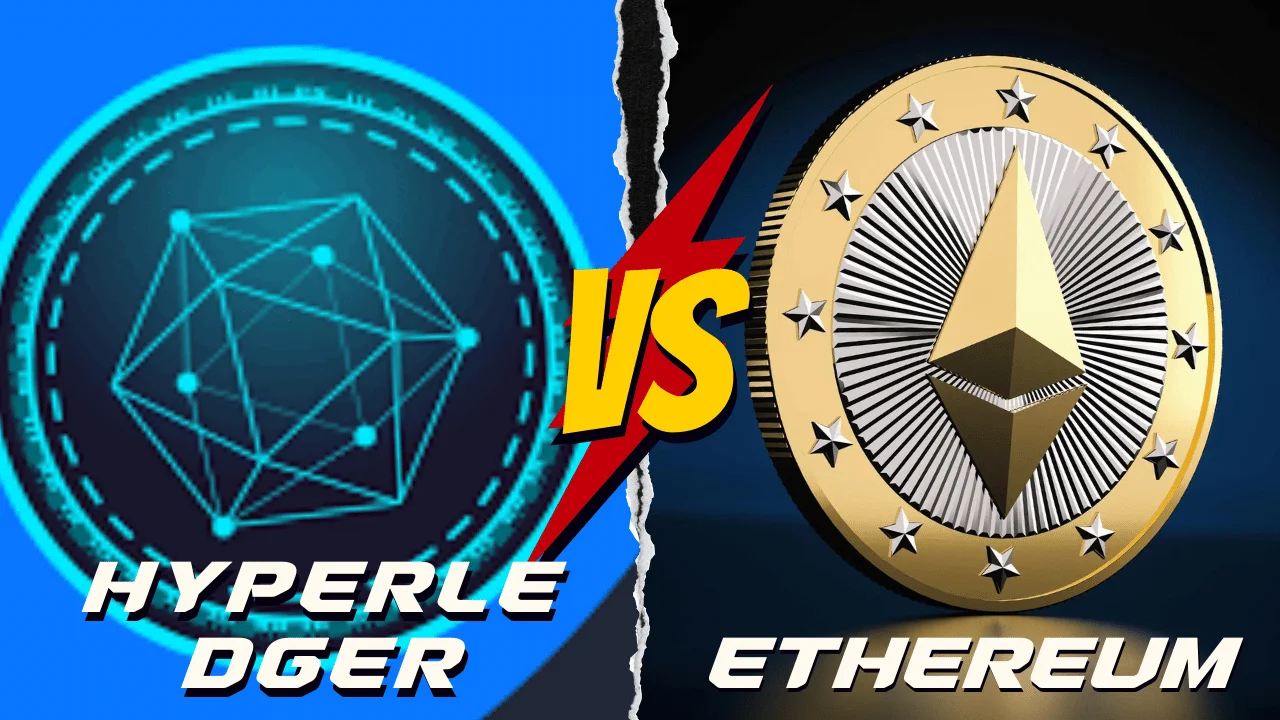In terms of both perception and management of digital transactions, blockchain technology has been revolutionary. The debate over blockchain’s possibilities and uses has heated up since the advent of platforms like Hyperledger vs Ethereum. Hyperledger and Ethereum are two competing blockchain platforms; this article compares and contrasts the two, looking at their respective strengths and weaknesses as well as the features and use cases that make them special.
Understanding Hyperledger and Ethereum
Hyperledger
Hyperledger is an enterprise-focused blockchain platform that was built as a collaborative effort by the Linux Foundation. It encompasses multiple projects that address different areas of blockchain technology. It runs on a private blockchain framework that only authorised participants can access, making it essentially a permissioned network. Because it permits private transactions and strict controls over network participation, this structure is useful for companies that value privacy and security. In contrast to native cryptocurrencies, Hyperledger’s modular design lets businesses modify the blockchain to meet their unique requirements, opening the door to a broad variety of uses.
Ethereum
Ethereum stands in stark contrast to Hyperledger as a publicly available blockchain platform that has gained renown for its capacity to facilitate internet-accessible smart contracts and decentralised applications (dApps). Ethereum’s adaptability stems from its capacity to enable programmers to create autonomous programmes that execute on a decentralised network, nurturing innovation in a wide range of domains. It processes transactions and operational fees using Ether, its native cryptocurrency. To improve scalability and lessen its environmental effect, Ethereum is switching from a Proof of Work (PoW) consensus mechanism to a Proof of Stake (PoS) one.
Privacy and Security in Blockchain Solutions
Hyperledger’s Enhanced Privacy Protocols
Hyperledger provides better privacy features due to its closed network environment. Businesses can rest easy knowing that their sensitive data is protected from unauthorised access while they conduct transactions. Businesses in the healthcare and financial sectors, where patient privacy is critical, will benefit greatly from this.
Ethereum’s Transparency and Security Measures
In addition to its public ledger that guarantees transparency, Ethereum has strong security protocols that protect the authenticity of transactions. By making it economically unfeasible to carry out malicious activities, the move towards a PoS consensus mechanism is expected to further secure the network against possible attacks.
Consensus Mechanisms
Byzantine Fault Tolerance in Hyperledger
The fact that Hyperledger has chosen PBFT as its consensus mechanism shows how seriously it takes issues of low power consumption and quick transactions. By reducing the number of nodes needed to validate transactions to a minimum, this method improves throughput and decreases latency.
Proof of Stake (PoS) in Ethereum
Moving to PoS is a major step forward for Ethereum’s network management. By rewarding validators through staking, this modification seeks to resolve scalability and energy consumption problems that are common in PoW systems, thus bringing their interests in line with the overall health of the network.
Applications and Use Cases
Hyperledger in Business Applications
Hyperledger works wonderfully in settings where there needs to be tight regulation of both network activity and transaction data. Its flexible and safe architecture allows it to run many business apps independently of a public ledger, making it ideal for sectors like finance, supply chain management, and government operations.
Ethereum for Decentralized Solutions
Crowdfunding platforms, decentralised finance (DeFi), and autonomous organisations are just a few examples of the types of applications that would thrive on Ethereum’s extensive network connectivity. Because it can execute smart contracts in a transparent and intermediary-free manner, it is a powerful tool for developing global trustless systems.
Key Metrics for Blockchain Efficiency
Hyperledger’s Modular Architecture
The hyperledger platform is able to adapt to the changing needs of enterprise applications thanks to its modular design. In addition to facilitating smooth integration with preexisting systems, this modular design aids in scaling the system to meet the demands of the organisation. Organisations can customise the blockchain to meet their operational needs by choosing components such as consensus models, ledger formats, and membership services.
Ethereum’s Network Expansion Strategies
During times of high demand, Ethereum has often experienced problems with network congestion and expensive petrol fees. Because of this, the Ethereum development team has made a number of changes to make the platform more scalable. The network’s capacity to process transactions per second (TPS) is anticipated to be substantially enhanced with the implementation of sharding and layer 2 solutions such as rollups, leading to a decrease in transaction costs and an improvement in transaction speed.
Transaction Processing and Throughput Comparison
The efficiency of a blockchain platform is highly dependent on the speed and throughput of transactions. Because of its permissioned structure and simplified consensus mechanisms, Hyperledger is able to process transactions at a faster rate than Ethereum. Because of this, it is perfect for businesses that handle a high volume of transactions rapidly. However, Ethereum’s continuous network upgrades are bringing about improvements in transaction speeds, which are usually slower due to Ethereum’s open and decentralised nature.
Ensuring Safe Blockchain Operations
Hyperledger’s Permissioned Environment
The limited network access in Hyperledger’s permissioned blockchain increases security and reduces the likelihood of hacking and fraudulent activities. Because everyone on the network is known and verified, security breaches are much less likely to occur. Industries that place a premium on data security and integrity must have this controlled access environment.
Ethereum’s Decentralized Security Protocols
Ethereum offers strong security features despite being an open network. Due to its distributed architecture, the network is immune to failure at any one node. In addition, switching to Proof of Stake should improve network security by making network manipulation more expensive and difficult for attackers.
Development Tools and Ecosystem
Tools and Libraries for Hyperledger Development
The many tools and libraries provided by Hyperledger make it easy for programmers to create, test, and release apps. Hyperledger Fabric and Hyperledger Sawtooth are two examples of projects that offer robust platforms on which businesses can build sophisticated apps. It is much simpler for inexperienced developers to begin developing enterprise-grade applications with these tools because of the robust documentation and active community that supports them.
Ethereum’s Vibrant Developer Community
When it comes to blockchain technology, Ethereum has one of the biggest developer communities. Truffle, Hardhat, and Brownie are all comprehensive development frameworks that make it easier to build decentralised applications, and they all contribute to this thriving ecosystem. In addition to building a wealth of information and resources, the Ethereum community encourages innovation through teamwork and the exchange of ideas.
FAQs
What is the main advantage of Hyperledger over Ethereum?
Hyperledger’s main advantage is its permissioned network setup, which offers enhanced privacy and security for enterprise applications.
Can Ethereum handle private transactions like Hyperledger?
Ethereum can handle private transactions using specific protocols like zero-knowledge proofs, but it’s naturally less private than a permissioned network like Hyperledger.
Is Hyperledger suitable for public applications?
Hyperledger is primarily designed for enterprise use and is not typically used for public applications due to its permissioned nature.
What programming languages can be used with Ethereum?
Ethereum primarily uses Solidity for smart contracts, but other languages like Vyper can also be used.
Can Hyperledger and Ethereum be used together in one project?
Yes, some projects integrate both Hyperledger and Ethereum to leverage the unique advantages of each platform, such as using Hyperledger for internal transactions and Ethereum for decentralized applications.
Also Read: IBM Blockchain Essentials: Guide for Developers
Conclusion
Hyperledger and Ethereum are two competing blockchain platforms that each have their own set of advantages and disadvantages. Companies concerned with security and privacy in their digital transactions should look into Hyperledger, while those interested in the increased accessibility and innovation offered by decentralised applications should consider Ethereum. With the ever-changing blockchain landscape, projects and enterprises will need to carefully consider their unique needs and long-term objectives before deciding between Hyperledger vs Ethereum.

Brandy Stewart, an enchanting wordsmith and seasoned blogger, weaves compelling narratives that transport readers to uncharted territories. Infused with perceptive viewpoints and dynamic storytelling, Doris exhibits a command of language that enthralls both hearts and minds, leaving a lasting mark on the literary panorama.

